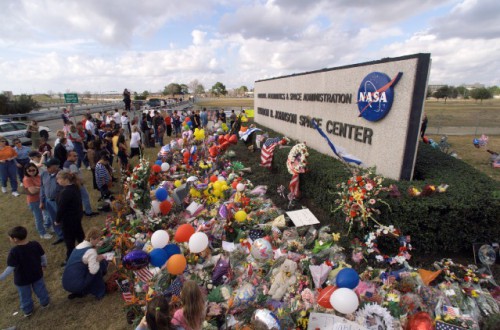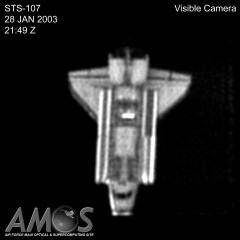
A few seconds after 8:58 a.m. EST on 1 February 2003, the otherwise normal re-entry profile of Columbia—which was already displaying many abnormal characteristics—changed abruptly from a vehicle barely in control to a ship in severe distress. Superheated plasma had entered a six-to-ten-inch-wide hole in the Reinforced Carbon Carbon (RCC) on the leading edge of her left wing and had proceeded to destroy virtually everything within; aluminum struts had melted and a good-sized portion of the wing itself had fallen away. The intense heat had crept into one of her landing gear wheel wells, alerting a puzzled Mission Control to “something” amiss, but no one could have foreseen the disaster that was about to engulf Columbia and her seven-strong crew.“The vehicle was in control and responding to commands up to that point,” said United Space Alliance manager Doug White. “After that point, something changed. The rates and the amount of muscle it needed to continue flying the vehicle the way it should be flown were continuing to increase. Something definitely happened to cause the flight control system to need more muscle and start having to fight harder.” It was not until the loss of tire pressure data triggered an alarm in the cockpit that Commander Rick Husband radioed Mission Control, but his words were cut off in mid-sentence. Presumably, crewmate Laurel Clark was still videotaping the progress of re-entry from her seat on the aft flight deck when the first of many master alarms began to blare. We shall never know.

Elevon adjustments were proving useless and could no longer prevent the shuttle’s nose from yawing to the left. At 8:59 a.m., two thruster firings—each lasting 1.5 seconds—were automatically commanded by the computers in an unsuccessful attempt to regain control. A second master alarm sounded in the cabin as the elevons’ control circuitry failed. Seconds later, ground-based observers in western Texas saw something large and bright falling away from the vehicle. In all likelihood, it was most of Columbia’s left wing. By 9:00 a.m., two more pieces of debris, probably the vertical stabilizer tail fin and one of the Orbital Maneuvering System (OMS) pods, also separated. In spite of this dire predicament, as she fell out of control, nose-first, with her left wing gone and probably several other critical hardware elements also missing, Columbia’s hydraulic power units and electrical generators remained fully operational. Her communications and navigation equipment also appeared to be working. Yet death for the orbiter and the crew was close. Master alarms would have echoed through the cockpit as the computers advised Husband and Pilot Willie McCool of fuel leaks, cooling system failures, extreme temperatures on the ship’s belly, and intermittent electrical glitches. According to recovered data from the Orbiter Experiments (OEX) recorder, found a few weeks later, the vehicle’s orientation was changing at a rate of 20 degrees per second. These motions alone subjected the airframe to stresses for which it had not been designed.

“Based on the debris and the track, I think the [left] wing disintegrated in pieces and we probably ended up with very little of the left wing actually attached before the entire orbiter broke up,” said Scott Hubbard of the Columbia Accident Investigation Board (CAIB). The computers “lost control and the wing started to come apart. The sense from that data is that the orbiter went into a flat spin, possibly even going backwards for some period of time.” At around this point, Columbia’s backup flight system recorded that one of the pilots’ hand controllers—normally used during final approach and landing—had been moved out of position, and there was speculation that Husband or McCool might have attempted to assume manual control. However, it seemed more likely that the stick was inadvertently bumped out of position in those horrific final minutes. Either way, Columbia’s digital autopilot remained in control until the loss of telemetry.
Astronaut Rick Searfoss, who flew a similar re-entry at the end of the STS-90 mission in mid-1998, wondered if Husband had a chance—a few seconds before the master alarms began blaring—to look out of his window and see the area of West Texas around the Red River, where he grew up. “We’ll never know,” Searfoss told an interviewer in the days after the disaster, “at least not in this lifetime.”
It is difficult not to surrender to a shudder when one imagines the situation aboard the orbiter in those last minutes. We can never know how Husband’s crew reacted upon realizing that their craft was physically disintegrating around them. Perhaps, mercifully, they would have been so engrossed in their instruments, trying to respond to multiple failures and alarms, that the end came quickly. All that is known with certainty is that the OEX recorder, found towards the end of March in a Texan field, stopped working at 9:00:18 a.m. EST.
At some point, within the next minute or two—as Capcom Charlie Hobaugh tried fruitlessly to regain radio contact with the orbiter, as Flight Controller Jeff Kling and Flight Director LeRoy Cain puzzled over erratic data, as Instrumentation Officer Laura Hoppe wondered how much longer the “ratty” communications would last, as off-duty Flight Director Bryan Austin saw multiple contrails in the sky outside his Houston home, as amateur videographers pondered the reason for the bright objects falling from the shuttle, as Andy Cline awoke with foreboding in his cabin in the Wyoming mountains, and as Evelyn Husband and her children got ready to pose next to the KSC countdown clock—seven astronauts died in the United States’ second shuttle disaster.
We will never forget them … or the sacrifice they made.
This is part of a series of history articles, which will appear each weekend, barring any major news stories. Next week’s article will focus on STS-60, a mission in February 1994 which began the most unlikely of international partnerships—between Russia and the United States—and paved the way for today’s International Space Station.




Ben Evans has written an excellent 3-part series on Columbia’s final flight. It reminds us of the very real dangers of spaceflight as well as the heroism of the seven brave astronauts. We as a species will continue to press on. May all those who have made the ultimate sacrifice to explore space remain in our thoughts and prayers.
Tom, I wholeheartedly agree with your post, Ben can always be counted upon to write truly exceptional articles. I respectfully submit for your consideration the book “Space Shuttle Columbia Her Missions and Crews” by Ben Evans. The book is, as is to be expected considering the author, excellent in every respect. It is published by Praxis Publishing Company ISBN: 0-387-21517-4 springeronline.com
Karol: Thanks. I will get Ben’s book. It will be an excellent companion, I am sure, to “Comm Check.”